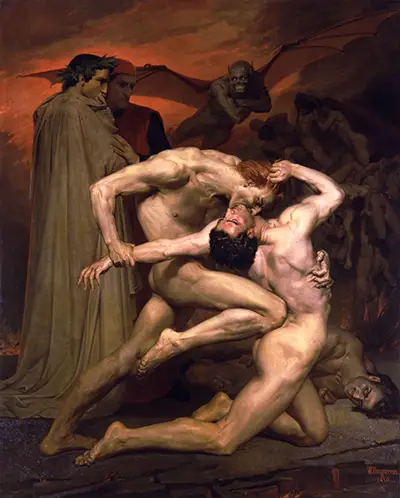April, 1300: Dante, wandering lost in the dark wilderness, sees a vague figure emerge from the darkness. It is Virgil, the Latin poet, in whose works Dante had found fruitful lessons in moral living and literary perfection.
Virgil indicates the road to salvation and becomes his guide through the meanders of hell. This meeting takes place in the first Canto of Inferno in Dante's "Divine Comedy". The horrific fight in this powerful painting by French realist painter William-Adolph Bouguereau (1825-1905) is a scene from Canto X X X.
Dante Alighieri gave us the terrifying images of hell that have shaped and perturbed the Christian conscience ever since the middle ages. Before Dante, divine punishment for sins was a vague, nebulous concept; Dante gave it substance, terrible substance. Dante's "Divine Comedy", particularly the part dedicated to hell, is full of solid, detailed descriptions of what goes on in the netherworld, and has greatly influenced the popular conception of purgatory and hell, inspiring both awe and fear.
Fortunately, it has also inspired many great artists who have applied paint to canvas and brought Dante's terrifying descriptions vividly to life, letting us actually view the awful fate that awaits unrepentant sinners. Bosch created his own depiction of Hell whilst Pieter Bruegel the Elder gave us Dull Gret and Triumph of Death.
The Roman poet, Virgil, was a forceful inspiration for Dante. His presence in the "Divine Comedy" was a homage to the poet - what better companion for wandering the terrifying pathways of the underworld than a fellow poet?
The choice of Virgil as the guide through hell was no doubt influenced by the fact that in Virgil's Aeneid there were descriptions of Aeneas crossing into the underworld, and by Dante's long-lasting admiration for the Latin poet.
Indeed, Dante's lines are a hymn to Virgil: "Tu se' lo mio maestro e 'l mio autore" (You are my mentor and my author), "You are the one that taught me the noble style that has earned me fame and honour amongst my contemporaries". In the painting we see Virgil, a supportive, reassuring presence, standing with Dante behind the fighting figures, surrounded by other demonic onlookers.
Dante and Virgil in Hell is oil on canvas and currently hangs in the Musée d'Orsay, in Paris. It was painted in 1850 by William-Adolph Bouguereau. It is a one-off, the artist never returned to this theme; maybe the intensity of the scene brought hell too close for comfort! The picture shows us Dante, accompanied by Virgil, wandering through the eighth circle of hell, the sector reserved for counterfeiters and falsifiers.
They stop to witness an infernal combat, an unending fight to the death. The horror of the action is forceful: we see one combatant savagely biting the neck of the other while brutally kneeing his back.
The desperation and the agony is strongly evident in the tense, straining muscles and the determined, combative faces. Yet, there is beauty here: the perfect, muscular bodies are depicted in harmonious lines which suggest a bold, supple strength. There is nothing static about the positions of the bodies, the scene is a fleeting moment of the combat - we fully perceive the movement and the fury of the fight.
This horrific fight is between two damned souls, both condemned to eternal combat. The hellish circle they inhabit is the eighth circle, reserved for those who cheat, falsify and counterfeit in order to immorally or illegally improve their lot at the expense of others. The biting fighter, Gianni Schicchi, is a usurper who fraudulently adopted a dead man's identity in order to obtain an inheritance. He was duly sent to hell. The other fighter is an alchemist and heretic called Cappocchio. In an age when heresy and alchemy were deadly sins, hell was the inevitable final destination.




